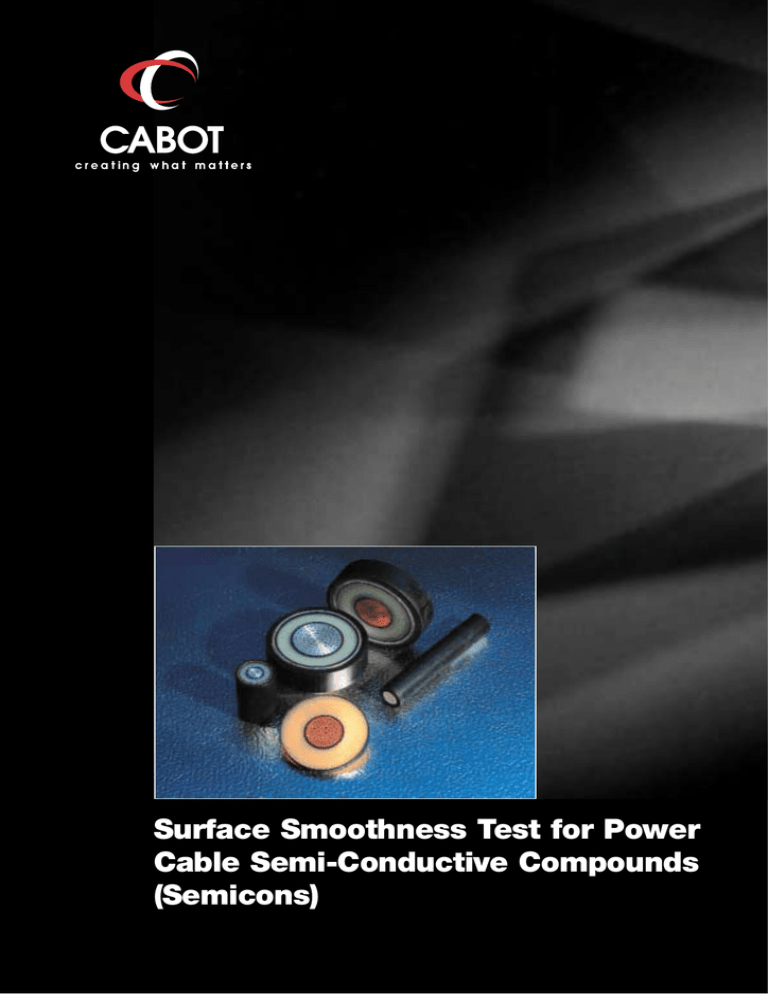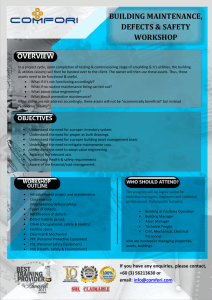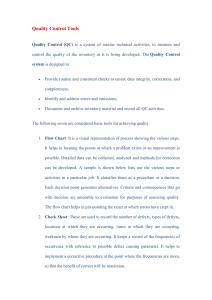
Surface Smoothness Test for Power
Cable Semi-Conductive Compounds
(Semicons)
Surface Smoothness Test for Power
Cable Semi-Conductive Compounds
(Semicons)
Mechanical imperfections protruding from the semi-conductive surface into the insulation (protrusions) amplify electrical stresses in proportion to the size and sharpness of the protrusions, thereby promoting tree growth (Figure 1) in the insulation and premature failure of the
cable. Acceptable cable life can only be achieved with smooth interfaces and low ion/low sulfur containing semi-conductive formulations,
as shown in Figure 2.
Effect of Surface Smoothness and
Chemical (Ions and Sulfur) Impurities on Cable Life
Surface Smoothness (Rating)
Figure 1: Growth of vented water trees.
Cable Life (Years)
Figure 2: Effect of surface smoothness
on cable life.
The performance of a conductive black in a semicon application is
therefore a function of the physical cleanliness of the conductive black
and the quality of its dispersion. Dispersion is, in turn, influenced by
the conductive black morphology, the pellet quality, the semicon formulation and the compounding technology. The conductive black
loading has also an influence on the results. Often, the higher the loading (for the same black), the better the surface smoothness. Indeed, if
the loading is increased, the shear during the mixing is also intensified
and thus, the dispersion can be improved. The surface smoothness
test measures the sum of these effects.
The surface smoothness test involves the continuous extrusion of a
formulated semicon tape (polymer filled with conductive black) through
a die, under controlled extrusion conditions, to achieve a constant
thickness. An on-line camera coupled to a computer simultaneously
registers images of the extruded tape surface and performs the image
analysis. The result is a detailed description of the number of defects
by size and by shape.
The system can detect protrusion, fish eyes, black spots, holes and
others inhomogeneities, putting them into 10 freely definable class
sizes. The quality of the resolution depends on the used optics being
the standard resolution 18µm.
2
Extrusion
Settings
Air-knife
Die
Extruder
Chill Roll
Tape
Figure 3: Previous extrusion of semicon tapes to
the on-line image analysis.
Principle
The measurement is done by reflection. Both the lighting unit and the
camera are installed beneath the tape (at a specific angle to each
other).
The lighting unit illuminates the tape and the line camera takes the
reflected images from the tape.
Figure 4: Tape travel
Figure 5: Lighting unit and detail of a sample being
inspected
The measurement of the defects is based on the attenuation of the
illumination. The defects are digitalized by a specially designed software, processed and evaluated by the difference of gray level (the
defects appear darker than the background).
Camera-Detector
(A)
Defect seen in height
Light source
Protusion
defect in
height
Tape horizon
Camera-Detector
Light source
(B)
Defect seen on the surface
OCS defect
Figure 6:
A) Smoothness as protrusions (height size)
B) Smoothness as OCS results (defects as area size)
The inspection system uses circle diameters for the classification of
defects. The shape and area of the defect are determined, then
reprocessed by the software and presented in circular form. This reimaged circle is of the same size as the defect itself and facilitates an
exact measurement.
A = π R2 = π/4 D2 = X * Y
subdivision
D = 2 √(X*Y/π)
A = area of circle
R = radius
D = diameter
X and Y are multiple of pixels
The results can be split by level (average defects/m2 for the predefined level (s)) and also by shape factor:
Shape Factor (S.F) = U2/(4πA)
U = Perimeter of the defect
A = Area of the defect
If the defect is a circle, then S.F. = 1 = (2πR)2 / (4π(πR2).
The longer the defect, the higher the shape factor.
Surface Smoothness Test
Experimental Conditions
The following parameters are used:
Extrusion temperature
Die, adaptator, and barrel (zones 2 & 3): 200 °C
Barrel (zone 1): 190 °C.
Screw rotor speed
Tape stretching speed
30 rpm
0.82 m/min.
Tape thickness
Chill-roll
250 µm
40°C
Film tension
Knife-air
Surface analyzed
6 Nw
switched on
1 m2
Gray level
Level
120
80
(Maximum settings: Torque<50 N and P< 250 bars).
Tape Smoothness
10000
Defects count (avg/[m2])
Defects count (avg/[m2])
Results (number of defects) of the measurement can be displayed
as bar charts classified by size (microns).
1000
100
10
1
0
50
0
0
0
00 500 750 100 1
-6 100 150 -20
-3
-
Defect Defect
size (µm)
size (µm)
0
50
>1
10000
1000
100
10
1
0
-6
0
0
00
00 150 200 300 500 750 100 150 15
>
-1
Defect
(µm)
Defect
sizesize
(µm)
SF< 2.5
Figure 7: Defect distribution and defect distribution for different shape factors.
SF< -4
SF> 4.0
Figure 8: Images of defects of various sizes for a typical semicon.
Semicon Classification
The critical surface smoothness quality level for a semi-conductive
layer in a power cable is determined mainly by defects (protrusions)
from 200µm up to bigger than 1000µm in size, with the critical size
value around 500µm.
Hence taking into account the size and the total number of defects
(from 200µm up to 1000µm) the next classification has been set up:
•
•
•
•
•
Supersmooth (class 10)
Smooth (class 8)
Medium quality (class 6)
Low quality (class 4)
Poor quality (class 2)
This classification is used to express the surface smoothness in the
star diagrams (Figure 9). The highest rank in the star diagram for
smoothness corresponds to the Supersmooth classification,
which indicates the lowest number of defects at comparable conductivity of the compounds.
Ease of Dispersion
2
Sulfur Content
10. Supersmooth
8. Smooth
6. Medium quality
4. Low quality
2. Poor quality
Conductivity
4
6
8
10 Surface Smoothness
Ionic Content
Specialty Semicon Black
Minimum Requirements for Fully-bonded Shields
Conventional Conductive Black
Figure 9: Star diagram for fully-bonded shields
5
CB/SMOOTHNESS/02.02/E
North America:
Europe:
Cabot Corporation
Business and Technical Center
157 Concord Road
Billerica, MA 01821-7001
USA
Tel: (978) 663-3455
Tel: (800) 462-2313 (Technical Service)
Fax: (978) 670-7035 (Technical Service)
Tel: (800) 526-7591 (North America Customer
Service)
Cabot
Interleuvenlaan, 5
B - 3001 Leuven
BELGIUM
Tel: +32 16 39 24 00
Fax: +32 16 39 24 44
South America:
Cabot Brasil Industria e Comercio Ltda
Av. Joao Castaldi 88
04517-900 Sao Paulo, SP
BRAZIL
Tel: +55 11 5536 0388
Fax: +55 11 5542 6037
Pacific/Asia:
Cabot Specialty Chemicals, Inc.
Level 14, MNI Tower 2
11, Jalan Pinang
50450 Kuala Lumpur
MALAYSIA
Tel: +60 3 2164-8352
Fax: +60 3 2162-0253
Middle East/Africa:
Cabot Specialty Chem. Inc.
Jebel Ali Free Zone
LOB 15, Office 424
Dubai
UNITED ARAB EMIRATES
Tel: +971 4 8871 1800
Fax: +971 4 8871 1801
Notice and Disclaimer. The data and conclusions contained herein are based on work believed to be
reliable; however, Cabot cannot and does not guarantee that similar results and/or conclusions will be
obtained by others. This information is provided as a convenience and for informational purposes only.
No guarantee or warranty as to this information, or any product to which it relates, is given or implied.
CABOT DISCLAIMS ALL WARRANTIES EXPRESS OR IMPLIED, INCLUDING MERCHANTABILITY OR
FITNESS FOR A PARTICULAR PURPOSE AS TO (i) SUCH INFORMATION, (ii) ANY PRODUCT OR (iii)
INTELLECTUAL PROPERTY INFRINGEMENT. In no event is Cabot responsible for, and Cabot does not
accept and hereby disclaims liability for, any damages whatsoever in connection with the use of or
reliance on this information or any product to which it relates.
©
Cabot Corporation, M.A. - U.S.A. All rights reserved.
www.cabot-corp.com/plastics



